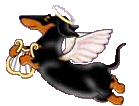
Not human bean, more than a human been!
 Skin
Skin
Some Dachshunds suffer from skin problems, such as baldness or lack
of pigmentation in their skin.
Dachshunds can develop skin sores because they are genetically prone to
developing allergies. Allergies increase the likelihood that flea bites
or yeast infections (Malassezia) will develop into moist, itchy hot
spots. Allergic Dachshunds can also develop Malassezia ear infections (otitis).
The skin of Dachshunds is also affected by a genetic tendency to develop
hypothyroid disease. Hypothyroid Dachshunds lose their hair and develop
darkened, thickened skin.
 Itchy
Itchy
ACANTHOSIS NIGRICANS: Overview (canine): Acanthosis nigricans is a poorly-understood condition in dogs in which the skin becomes blackened. The process typically starts in the armpits and groin and the skin becomes thick, greasy and heavily pigmented. Inflammatory pigmentation is common in dogs, but this condition is distinct. The diagnosis is verified by biopsies for histopathologic assessment. Treatment is sometimes successfiil with topical therapies, oral vitamin E, topical corticosteroids and injectable melatonin. Mode of Inheritance: Not known but presumed to be autosomal recessive or polygenic.
Acanthosis nigricans, unfortunately, seems to be unique to the Dachshund.
read more in the blog
Recommendations: Do not breed affected animals, their siblings or their parents. No screening tests currently avallable for caniers.
Flea Allergy – Flea allergy or flea allergy dermatitis is an allergy caused by flea saliva passed into the dog's skin when it bites. Not all dogs can acquire flea allergy with a single bite but dogs with flea allergy will quickly experience the symptoms such as itching, redness and swelling. Symptoms of flea allergy are scratching, loss of hair, crusts and erosions of the skin and pimple-like bumps. In some severe cases, thickened skin with darkened areas will develop. Red, oozing and very painful sores are also present in this kind of allergy. This problem is best prevented through eliminating the fleas in the environment. It is important to keep your surroundings clean to make sure that fleas are completely removed. The market is offering wide selection of commercial products used to kill fleas. Just read the label carefully as to the proper usage of the product, or it is better to ask your vet for suggestions.
Bathe your dachshund only when he smells bad, gets very dirty, or is shedding excessively. Bathing him too often will dry out his skin. Wash your dachshund in a bathroom tub or utility sink—or even the kitchen sink if you have a miniature. Place a rubber mat at the bottom of the tub or sink to prevent your dachshund from slipping.
Bathing Tools and Procedure
1. Wet your dog’s coat thoroughly with warm water.
2. Wet his head as well, but tilt it back so that water doesn’t get in his eyes.
3. Avoid getting water in his ears, or gently insert cotton balls into the opening to keep out water.
4. Lather your dachshund well with dog shampoo, rubbing your hands with and against the coat in circles.
5. Once you’ve shampooed your dachshund, rinse him thoroughly, making sure to get every last bit of soap out of the coat.
6. Dry him with a towel or a hair dryer set to a low setting, being sure not to burn or frighten him.
Brushing and bathing your dachshund will help to keep his coat and skin healthy.
Brushing Your Dachshund
Each of the three dachshund coat types—smooth, wirehaired, and longhaired—sheds, and each one requires brushing to get rid of dead hair and keep his coat shiny. Regular brushing also limits the amount that your dachshund sheds around the house. Brush your dachshund weekly when he is not shedding actively and at least every other day when he is shedding excessively.
Brushing Tools and Procedure
There are three different ways to brush the three varieties of dachshund coats:
* Smooth dachshund: Use a soft bristle brush or a slicker brush to remove dead hair from his coat. A rubber currycomb also will help to loosen the coat when your smooth dachshund is shedding heavily. When brushing, follow the grain of the coat from neck to tail.
* Wirehaired dachshund: Wirehaired dachshunds are often groomed with clippers or stripped by professional groomers. Stripping, a method that involves plucking out dead hair, can be done with special stripping knives or by hand. Wirehaired dachshunds need special attention paid to their eyebrows and beards.
* Longhaired dachshund: A soft bristle or slicker brush will work well for a longhair, but pay particular attention to his elbows and behind the ears because these areas are usually the first to mat. Comb that hair out, gently working out any snarls or knots with your fingers. Eventually his “shawl,” the longer hair around his neck, also will need to be thinned, but this may be a job better suited to a professional groomer.
Brush your dachshund’s sides, chest, neck, belly, legs, and tail. Avoid sensitive areas such as the nose and eyes. While brushing, always have treats handy in case you accidentally make him uncomfortable.
